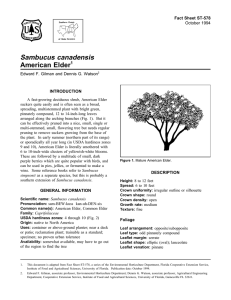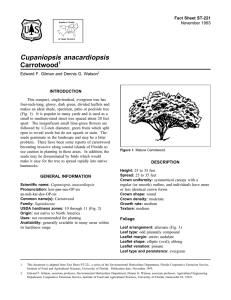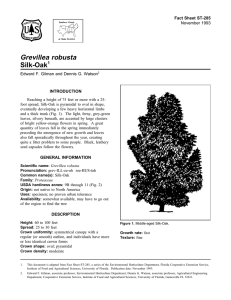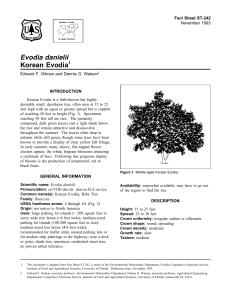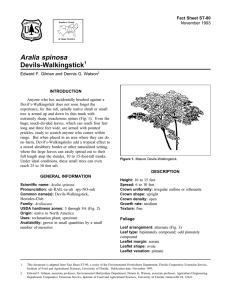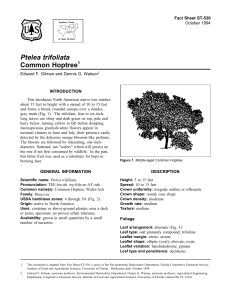Sambucus mexicana Mexican Elder Fact Sheet ST-580 1
advertisement
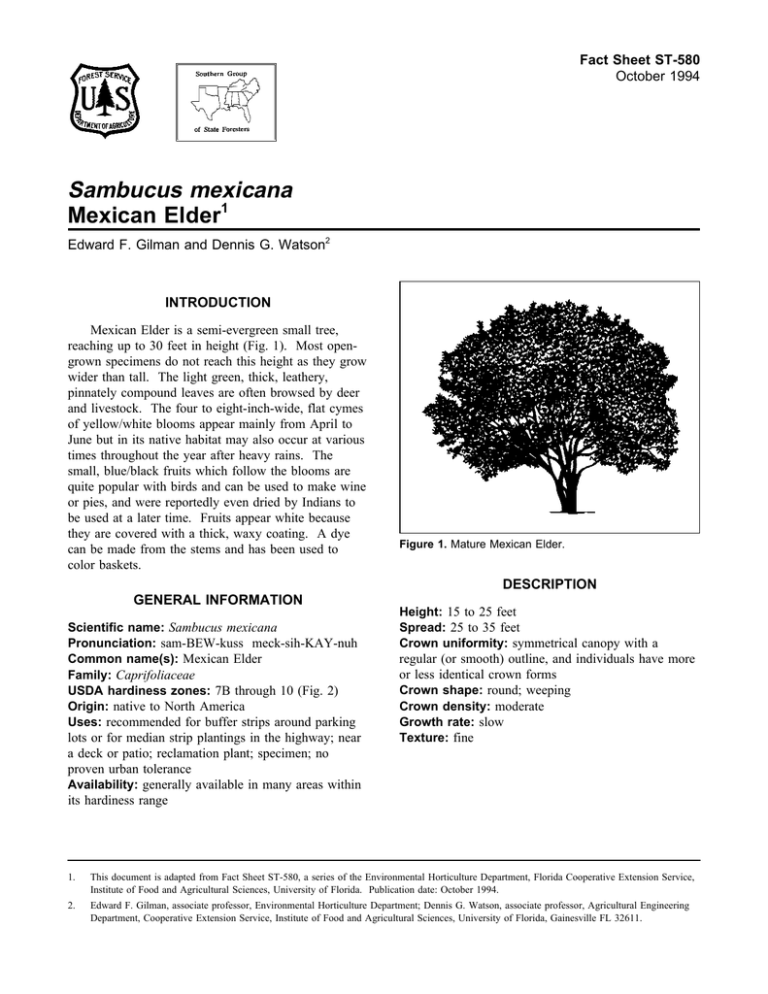
Fact Sheet ST-580 October 1994 Sambucus mexicana Mexican Elder1 Edward F. Gilman and Dennis G. Watson2 INTRODUCTION Mexican Elder is a semi-evergreen small tree, reaching up to 30 feet in height (Fig. 1). Most opengrown specimens do not reach this height as they grow wider than tall. The light green, thick, leathery, pinnately compound leaves are often browsed by deer and livestock. The four to eight-inch-wide, flat cymes of yellow/white blooms appear mainly from April to June but in its native habitat may also occur at various times throughout the year after heavy rains. The small, blue/black fruits which follow the blooms are quite popular with birds and can be used to make wine or pies, and were reportedly even dried by Indians to be used at a later time. Fruits appear white because they are covered with a thick, waxy coating. A dye can be made from the stems and has been used to color baskets. Figure 1. Mature Mexican Elder. DESCRIPTION GENERAL INFORMATION Scientific name: Sambucus mexicana Pronunciation: sam-BEW-kuss meck-sih-KAY-nuh Common name(s): Mexican Elder Family: Caprifoliaceae USDA hardiness zones: 7B through 10 (Fig. 2) Origin: native to North America Uses: recommended for buffer strips around parking lots or for median strip plantings in the highway; near a deck or patio; reclamation plant; specimen; no proven urban tolerance Availability: generally available in many areas within its hardiness range Height: 15 to 25 feet Spread: 25 to 35 feet Crown uniformity: symmetrical canopy with a regular (or smooth) outline, and individuals have more or less identical crown forms Crown shape: round; weeping Crown density: moderate Growth rate: slow Texture: fine 1. This document is adapted from Fact Sheet ST-580, a series of the Environmental Horticulture Department, Florida Cooperative Extension Service, Institute of Food and Agricultural Sciences, University of Florida. Publication date: October 1994. 2. Edward F. Gilman, associate professor, Environmental Horticulture Department; Dennis G. Watson, associate professor, Agricultural Engineering Department, Cooperative Extension Service, Institute of Food and Agricultural Sciences, University of Florida, Gainesville FL 32611. Sambucus mexicana -- Mexican Elder Page 2 Figure 2. Shaded area represents potential planting range. Foliage litter; persistent on the tree; showy Leaf arrangement: opposite/subopposite (Fig. 3) Leaf type: odd pinnately compound; trifoliate Leaflet margin: serrate Leaflet shape: elliptic (oval); ovate Leaflet venation: pinnate Leaf type and persistence: semievergreen Leaflet blade length: 2 to 4 inches Leaf color: green Fall color: no fall color change Fall characteristic: not showy Trunk and Branches Flower Flower color: white Flower characteristics: showy; spring flowering Trunk/bark/branches: droop as the tree grows, and will require pruning for vehicular or pedestrian clearance beneath the canopy; routinely grown with, or trainable to be grown with, multiple trunks; showy trunk; no thorns Pruning requirement: requires pruning to develop strong structure Breakage: susceptible to breakage either at the crotch due to poor collar formation, or the wood itself is weak and tends to break Current year twig color: brown; green Current year twig thickness: thick Culture Fruit Fruit Fruit Fruit Fruit Fruit shape: round length: < .5 inch covering: fleshy color: black; white characteristics: attracts birds; suited for human consumption; fruit, twigs, or foliage cause significant Light requirement: tree grows in full sun Soil tolerances: clay; loam; sand; acidic; alkaline; well-drained Drought tolerance: high Sambucus mexicana -- Mexican Elder Page 3 upright branches and remove the drooping ones to create greater clearance beneath the canopy. Mexican Elder should be grown in full sun on well-drained soil. Propagation is by seed. Pests and Diseases No pests or diseases of major concern. Figure 3. Foliage of Mexican Elder. Other Roots: surface roots are usually not a problem Winter interest: tree has winter interest due to unusual form, nice persistent fruits, showy winter trunk, or winter flowers Outstanding tree: tree has outstanding ornamental features and could be planted more Invasive potential: little, if any, potential at this time Ozone sensitivity: sensitive or moderately tolerant Verticillium wilt susceptibility: susceptible Pest resistance: no pests are normally seen on the tree USE AND MANAGEMENT Trees are best located in the open where they can develop their low, wide-spreading, uniform crown. It might be planted near a patio, or as a small shade tree in a backyard garden but the dropping fruit can be messy on brick, concrete and other hard surfaces. Young trees often require training and pruning to speed formation of a uniform crown. Save the more
